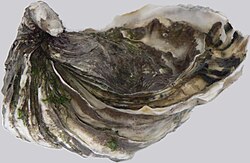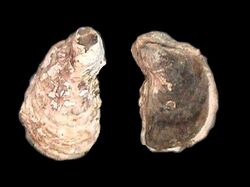Biology:Ostreidae
| Ostreidae | |
|---|---|

| |
| Pacific oyster, Magallana gigas | |
| Scientific classification | |
| Domain: | Eukaryota |
| Kingdom: | Animalia |
| Phylum: | Mollusca |
| Class: | Bivalvia |
| Order: | Ostreida |
| Superfamily: | Ostreoidea |
| Family: | Ostreidae Rafinesque, 1815 |
| Genera | |
|
12-15, See text. | |
The Ostreidae, the true oysters, include most species of molluscs commonly consumed as oysters. Pearl oysters are not true oysters, and belong to the order Pteriida.
Like scallops, true oysters have a central adductor muscle, which means the shell has a characteristic central scar marking its point of attachment. The shell tends to be irregular as a result of attaching to a substrate.
Both oviparous (egg-bearing) and larviparous (larvae-bearing) species are known within Ostreidae. Both types are hermaphrodites. However, the larviparous species show a pattern of alternating sex within each individual, whereas the oviparous species are simultaneous hermaphrodites, producing either female or male gametes according to circumstances.
Members of genus Ostrea generally live continually immersed and are quite flat, with roundish shells. They differ from most bivalves by having shells completely made up of calcite, but with internal muscle scars of aragonitic composition. They fare best in somewhat oligotrophic water. They brood their fertilized eggs for various proportions of the period from fertilization to hatching.
Members of genera Saccostrea, Magallana, and Crassostrea generally live in the intertidal zone, broadcast sperm and eggs into the sea, and can thrive in eutrophic water. One of the most commonly cultivated oysters is the Pacific oyster, which is ideally suited for cultivation in seawater ponds.
Genera and species
- Alectryonella
- Agerostrea Vialov 1936
- Anomiostrea
- Booneostrea
- Crassostrea Sacco 1897 (27 species)
- Magallana Salvi & Mariottini 2016[1]
- Magallana angulata (Lamarck, 1819)[2]
- M. ariakensis (Fujita, 1913)[2]
- M. belcheri (G. B. Sowerby II, 1871)[2]
- M. bilineata (Röding, 1798)[2]
- M. dactylena (Iredale, 1939)[2]
- M. gigas (Thunberg, 1793)[2]
- M. hongkongensis (Lam & Morton, 2003)[2]
- M. nippona (Seki, 1934)[2]
- M. revularis (Gould, 1861)[2]
- M. sikamea (Amemiya, 1928)[2]
- Cryptostrea Harry 1985 (synonymous with Ostrea[3])
- C. permollis G.B.Sowerby II 1871 - sponge oyster
- Dendostrea Swainson 1835 (12 species)[4]
- Lopha Röding 1798
- L. cristagalli L. - cockscomb oyster
- L. frons L. 1758
- Nanostrea
- Nicaisolopha Vyalov 1936
- Ostrea L. 1758 (approx. 120 species)
- Planostrea
- Pretostrea
- Pustulostrea
- Saccostrea (11 species)
- Striostrea
- S. margariacea Lamarck 1819 - sand oyster
- S. denticulata Born 1778
- S. prismatica Gray 1825
- Teskeyostrea Harry 1985
- T. weberi Olsson 1951 - threaded oyster, Weber oyster
References
| Wikimedia Commons has media related to Ostreidae. |
- ↑ Salvi, Daniele; Mariottini, Paolo (4 July 2016). "Molecular taxonomy in 2D: a novel ITS2 rRNA sequence-structure approach guides the description of the oysters' subfamily Saccostreinae and the genus Magallana (Bivalvia: Ostreidae)" (in English). Zoological Journal of the Linnean Society 179 (2): 263–276. doi:10.1111/zoj.12455. ISSN 0024-4082. OCLC 7145306501.
- ↑ 2.0 2.1 2.2 2.3 2.4 2.5 2.6 2.7 2.8 2.9 Bouchet, P.; Marshall, B. (2016). Magallana Salvi & Mariottini, 2016. In: MolluscaBase (2017). Accessed through: World Register of Marine Species at http://www.marinespecies.org/aphia.php?p=taxdetails&id=836032 on 2017-12-22
- ↑ Bouchet, P.; Gofas, S. (2017). Cryptostrea Harry, 1985. In: MolluscaBase (2017). Accessed through: World Register of Marine Species at http://www.marinespecies.org/aphia.php?p=taxdetails&id=415253 on 2017-12-21
- ↑ "WoRMS - World Register of Marine Species - Dendostrea Swainson, 1835". https://www.marinespecies.org/aphia.php?p=taxdetails&id=415280.
Wikidata ☰ Q21154 entry
 |


